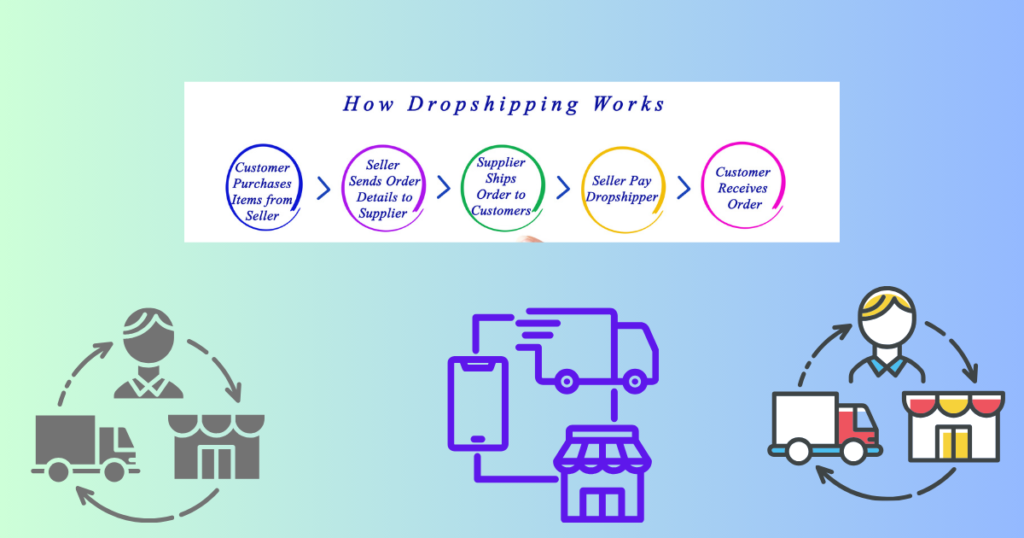What Is Dropshipping?
Dropshipping is an order fulfillment method that doesn’t require a brick-and-mortar store. With a low startup cost, it’s a popular business model, enabling aspiring entrepreneurs to start their own businesses with minimal investment.
The dropshipping model is easy to use, scale, and manage. With it, anyone can launch an online store without any inventory or logistical troubles.
Everyone’s welcome to dropship, but success requires a deeper understanding of this business model and the industry as a whole, which is where our guide – Dropshipping for Beginners – can help.
Many have quit their full-time job to start dropshipping and make good money from the comfort of their home. Success stories abound.
As a business model, dropshipping is very alluring – anyone can start their own business without worrying about order fulfillment, storage space, or shipping, leaving all the heavy lifting to a third-party supplier.
With our guide to dropshipping for beginners, starting a successful dropshipping business has never been easier – we’ll show you how, step by step.
How Does Dropshipping Work?

With the dropshipping model, eCommerce store owners sell a third-party supplier’s products and take a cut for themselves without ever holding any inventory. The products move directly from the supplier to the end customer.
In short, this is how dropshipping works: You create an online store and partner with a dropshipping supplier like Alibaba – listing their products as your own. A customer buys from you, paying you the retail price. You forward the order information to the supplier, paying the wholesale price. The supplier fulfills the order and ships directly to your customer’s doorstep.
Advantages and Disadvantages of Dropshipping
When it comes to learning how to dropship, understanding the benefits and drawbacks of this business model is vital for long-term success.
Advantages of dropshipping
With various indisputable advantages, dropshipping is a great way to make money for new and experienced entrepreneurs.
- Low investment. Arguably, the biggest benefit of dropshipping is that you purchase a product only after a customer buys from you. It’s an inexpensive and risk-free way to start an online business.
- Easy to start. While traditional entrepreneurs need various skill sets to run a business, dropshippers don’t need that much experience. Suppliers take care of production, warehousing, packaging, and shipping. Wide selection of products. Dropshipping companies provide various different items. Without having to worry about storage space or unsold stock, store owners can offer a wide selection of products.
- Ability to scale quickly. With suppliers doing all the heavy lifting, you have more time to focus on marketing, increasing sales, and growing their business.
- Work from anywhere. As a dropshipper, you can work from any location you like, effortlessly managing all operations from the comfort of your home
Disadvantages of Dropshipping
As with everything, it has its own set of limitations. To overcome challenges, it’s important to understand what they are and act accordingly.
Low-profit margin. For suppliers to provide their services, you have to pay slightly more compared to wholesale prices. Unless you sell
high-ticket dropshipping products, profit margins are generally lower.
Shipping complexities. If you work with multiple suppliers, logistics can become a hassle. When customers order several items available only from different suppliers, a business faces separate shipping costs.
Non-existent customization. Unlike Print on Demand, dropshipping doesn’t give you the freedom to customize the products you sell. They need to compete with businesses that all sell the same merchandise.
7 Easy Steps to start your dropshipping business

Step 1: Analyze the Market
When performed right, the market analysis provides valuable and actionable insights: current trends, consumer sentiment, and the state of the competition. With this data, dropshipping for beginners becomes much easier.
A few tried-and-tested ways to perform research:
Identify trends. Tools like Google Trends, Semrush, and Ahrefs are useful for identifying trends, gathering data on consumer interest, and checking the popularity of particular products.
Browse marketplaces. Amazon, eBay, and Etsy are great for checking what’s currently trending and appeals to customers worldwide. Analyze competition. Search and study popular dropshipping stores. Analyze their product offering, customer feedback, pricing, and marketing strategy. With a deep understanding of the market, you can find what it’s missing, filling the gap with dropshipping products nobody else has.
Step 2: Select a Niche
After the research, you need to select a niche to stand out among the competition. What is a niche? In short, it’s a product that strongly appeals to a specific audience. Like a t-shirt for cat moms or aprons for dads who are BBQ kings. With an appealing niche, sales come easier, the competition is lower, and the profits are higher.
When choosing a niche, start with what you’re passionate about and go from there. While it may seem tricky, it’s much easier than you imagine. Here’s how.
Typically, a niche should be as narrow as possible yet large enough to offer a profit potential.
Step 3: Choose Dropshipping Products
When building a dropshipping store, it’s essential to create a collection of high-quality products people enjoy. You can find best-selling products with research tools like Sell The Trend, AliShark, and Niche Scraper. They use algorithms to analyze products from various platforms and marketplaces, providing valuable insights into consumer demand.
Step 4: Choose Suppliers
Without a trustworthy supplier, starting a successful business is impossible. When choosing your dropshipping partner, keep the following in mind.
Location. With a local supplier, the shipping costs are lower, and the delivery time – faster. Selection of products. When a business starts gaining attention, diversifying product offerings is an easy way to increase sales.
Minimum order size. If you’re a beginner, choose a supplier that doesn’t require a minimum order size.
Ease of integration. After choosing a sales channel, ensure the supplier’s system integrates seamlessly. Always carefully research the supplier – examine their website, read verified reviews and customer feedback, explore search results, and get in touch with them to make sure they’re a legitimate and reliable company.
Step 5: Create a Brand
Good branding sets a business apart from others – by creating a brand that feels familiar to your customers, it’s easier to attract their attention, convey the quality of your products, and build a reputation.
A brand includes a business name, logo, color palette, and overall aesthetic that should be consistent across all channels.
Business Name
A good business name clearly communicates what a store sells, reflecting the heart and soul of a company. Try to come up with a name that’s simple, original, easy to spell, pronounce, and remember.
Logo
A logo represents the company, reflecting its personality and values – a cue that triggers emotions through visuals. When creating a logo, make it:
Relevant. Convey what your company does in some way. Iconic. Inspire trust by creating a high-quality logo that stands out. Use easy-to-read fonts and avoid clutter.
Step 6: Choose a Sales Channel and Set up a Store
Whether you sell on an eCommerce platform or marketplace, both offer an easy way to set up a store.
eCommerce Platform
A software application that allows a business owner to create their own stand-alone store and sell to customers worldwide.
Each has slightly different features and capabilities, so make sure it has everything you need: payment gateway options, marketing tools, and analytics
| Advantages | Disadvantages | Examples |
| More control over customer’s data | Some require technical knowledge | Squarespace |
| Easier to re-target customers | Higher marketing costs | BigCommerce |
| Hassle-free customization | Takes time to set up | Shopify |
eCommerce Marketplace
A single platform that hosts many stores.
They’re like a large online shopping mall, giving entrepreneurs access to a vast, pre-existing customer base.
Setting up a store on a marketplace is super easy, but you have less freedom over your store’s design and content.
| Advantages | Disadvantages | Examples |
| Easy to maintain | Higher competition | Walmart |
| Quick setup | Strict policy | eBay |
| Great for beginners | Selling fees | Etsy |
| Pre-existing traffic | Less competition |
Useful tips

Tip 1
Weigh the pros and cons of the best sites to sell online to choose the most suitable for your dropshipping business. Once you’ve chosen your sales channel, create a store that fits your brand, highlights your products, and drives sales. Setting up a storefront will vary depending on the sales channel, but there are a few basic principles to remember. Provide thorough information. Inspire trust by adding as much relevant information as possible. Include an About Us, Contact Us, and Frequently Asked Questions page so customers know the company is legitimate.
Add store policies. They give customers peace of mind, making them confident about their online purchases. Add delivery, return, exchange, and privacy policies. Use high-quality images. Use beautiful images that accurately reflect the item a customer will receive.
Tip 2
While creating a storefront isn’t difficult, hiring a storefront-setup expert is a great way to save time and trouble. Gain inspiration from the most successful Shopify stores and explore how professional entrepreneurs design them.
Step 7: Market Your Dropshipping Store
In eCommerce, marketing is everything. Dropshipping stores would never reach their target audience without an effective marketing strategy.
A few ways to market a dropshipping business: Social media. Strive to create content that encourages customers to make a purchase: post high-quality images, run engaging contests, and offer giveaways. Influencers. By collaborating with influencers, spreading the word about a brand is easier. Influencers have a loyal following that trusts their judgment. Try to partner with those whose values align with yours.
Content marketing. If you consistently deliver valuable content – useful articles, insights, engaging reviews – you’ll build trust, authority, and a loyal customer base. Email marketing. A cost-effective way to reach customers directly. Try tools like Mailchimp or Omnisend to automate the process and increase sales.
SEO tools. Search engine optimization (SEO) is the process of optimizing a website to rank higher in search results and drive more traffic.
Start optimizing by including relevant keywords (find them with Semrush or Ahrefs) in titles, product descriptions, alt-texts, and throughout the store.



